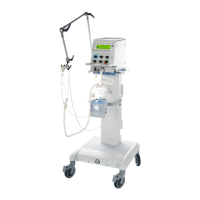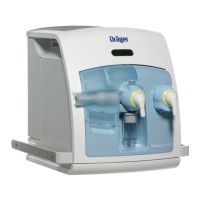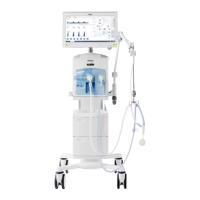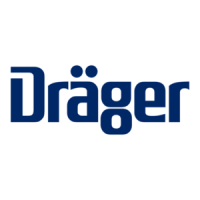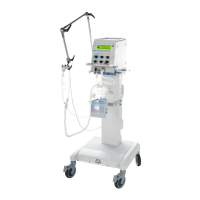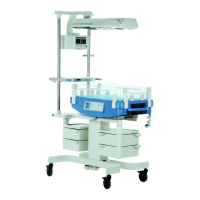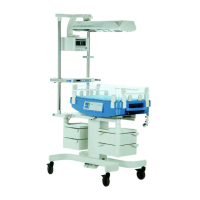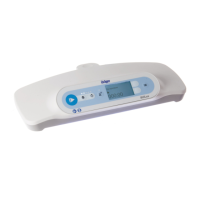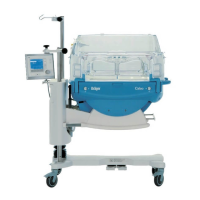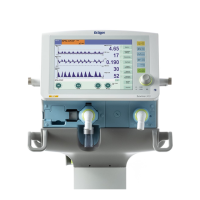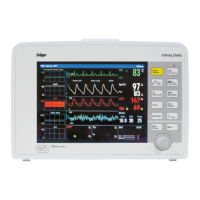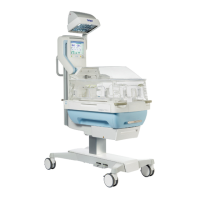
Do you have a question about the Dräger Babyleo TN500 and is the answer not in the manual?
| Brand | Dräger |
|---|---|
| Model | Babyleo TN500 |
| Category | Medical Equipment |
| Language | English |
Explains text formatting conventions used in the manual, including bold text, numbering, symbols, and arrows.
Defines Dr auml;ger's usage of the term 'accessory', extending beyond standard definitions to include consumable and removable parts.
Notes that illustrations may differ from actual products based on configuration.
Describes the Babyleo TN500's function as an incubator and radiant warmer for premature babies and neonates.
Provides fundamental guidelines for safe operation, emphasizing adherence to instructions and proper monitoring.
Details precautions for preventing electric shock and issues related to electromagnetic compatibility (EMC).
Covers risks like tipping over, trapping body parts, patient falling out, and unintended trolley movement.
Describes the device components and their functions in a table format.
Provides a labeled diagram of the device, identifying key components like the radiant warmer and display unit.
Details the components of the display unit, including the alarm light, touch screen, and rotary knob.
Describes the structure of the main screen and basic control options, including different therapy views.
Explains how to use the display unit to change therapy settings and interpret device indicators.
Details the procedure for adjusting the device height using foot pedals, including safety warnings.
Describes the operation of hand ports and access panels for patient care and compartment access.
Specifies the maximum weight limits for different areas of the device and its accessories.
Explains the function of the nurse call system for transmitting alarms to the central hospital alarm system.
Details the necessary checks to ensure the device is ready for safe and correct operation.
Provides a step-by-step guide on how to power on the device and perform the initial self-test.
Compares incubator and radiant warmer operation, including modes, settings, and applications.
Details how to use skin temperature mode for regulating patient temperature in both incubator and warmer.
Explains how to set and manage air temperature in the patient compartment during incubator operation.
Describes manual setting of the radiant warmer power, with features for patient protection.
Explains alarm priorities (High, Medium, Low) and their visual/auditory indicators.
Covers manual and proactive suppression of acoustic alarm signals and automatic delay of signals.
Details how to dismiss alarm messages after the fault has been remedied or for specific alarm types.
Guides on how to input patient information, which influences suggested air temperature ranges.
Explains how to export and import configuration and patient data using a USB mass storage device.
Covers device settings, including factory settings, user-specific, and patient-specific configurations.
Details the procedure for moving the patient and device within the hospital without active warming therapy.
Provides a comprehensive list of alarms, their causes, and recommended remedies for fault resolution.
Describes the conditions and remedies for a power failure alarm, including device shutdown procedures.
Details common faults encountered during weighing, such as inaccurate readings or taring issues.
Addresses issues related to oxygen supply, including pressure problems and alarm conditions.
Explains the process for automatic cleaning of the humidifier unit to ensure hygiene.
Provides an overview and procedure for disassembling the device components for reprocessing.
Details surface disinfection methods and cleaning procedures for the device and its parts.
Outlines required inspection and safety checks for the device, including intervals and target groups.
Lists components requiring maintenance, their intervals, and the required measure (e.g., replace).
Explains how to activate licensed applications using activation codes loaded from USB or entered manually.
Specifies operating and storage/transportation conditions for temperature, pressure, and humidity.
Lists technical specifications for power supply, gas supply, dimensions, and connectors.
Details operating noise, alarm volume, and performance specifications for various modes.
Describes connections for central alarm, COM port, USB port, and audio interface for data transfer.
Explains skin temperature regulation in incubator and radiant warmer modes, including comparisons.
Details the device functions that are automatically tested upon startup, continuously, and in other modes.
Lists the available interfaces on the device, including description and connected devices.
Provides the default configuration password and information on password protection for device settings.
